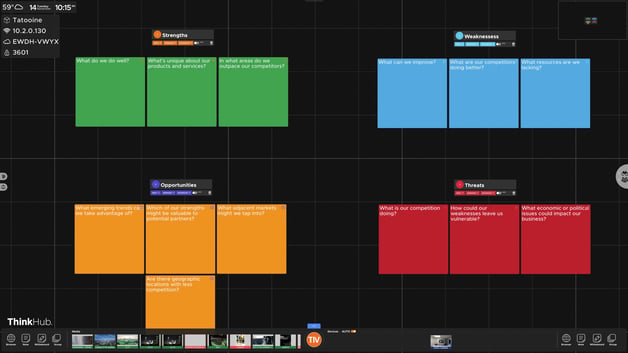With ThinkHub's interactive capabilities, you and your team can efficiently analyze and strategize around the results of the SWOT analysis, fostering more informed decision-making and strategic planning. Here's how to get started:
A SWOT analysis is a strategic planning tool used to assess an organization's internal strengths and weaknesses, as well as external opportunities and threats. The acronym "SWOT" stands for Strengths, Weaknesses, Opportunities, and Threats. This comprehensive evaluation helps businesses and individuals identify key factors that can influence their success, allowing for informed decision-making and the development of effective strategies. By analyzing internal and external factors, a SWOT analysis provides valuable insights into the current state and potential future of an entity, serving as a foundation for strategic planning and goal setting.
Here's how to set up a SWOT analysis on ThinkHub:

Step 1: Set the Stage
Start by creating a ThinkHub canvas dedicated to your SWOT analysis. Create 4 Groups: Strengths, Weaknesses, Opportunities, and Threats. This sets a clear visual foundation for the discussion.
Step 2: Real-Time Collaboration
Invite your team members to the ThinkHub canvas. Whether they're in the same room or working remotely, ThinkHub enables real-time collaboration. Each member can contribute to the analysis simultaneously, fostering a dynamic and inclusive environment.
Step 3: Populate the Quadrants
Encourage team members to populate the respective quadrants with their insights. Create notes, upload images, or draw diagrams. This not only captures diverse perspectives but also allows for a rich, visual representation of factors affecting your business.
Step 4: Update
As the discussion unfolds, leverage ThinkHub's dynamic nature to make instant updates. Rearrange elements, add new insights, or remove outdated information seamlessly. The fluidity of the platform ensures that your SWOT analysis remains current and adaptable.
Step 5: Analyze
Use ThinkHub's tools to draw connections and relationships between different elements of your SWOT analysis. Whether it's showcasing how strengths can counteract threats or how weaknesses might impact opportunities, visualizing relationships adds depth to your strategic insights.
